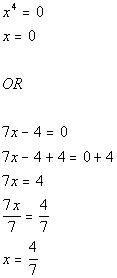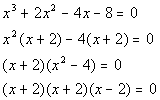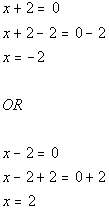College Algebra
Tutorial 18:
Solving Polynomial Equations
by Factoring
 Learning Objectives
Learning Objectives
|
After completing this tutorial, you should be able to:
-
Write a polynomial equation in standard form.
-
Use the zero factor property.
-
Solve polynomial equations by factoring.
|
 Introduction
Introduction
|
| In this tutorial we will be putting our factoring skills to the test
again. We will be looking at solving polynomial equations, which
include quadratic equations, by factoring. After completing
this tutorial, you will be a master at solving polynomial equations.
Solving equations in general is a very essential part of algebra.
So I guess we better get to it. |
 Tutorial
Tutorial
|
| A polynomial equation is one polynomial set equal to another polynomial.
If you need a review on polynomials, feel free to .
The following is an example of a polynomial equation:

|
|
Standard Form of a Polynomial
Equation

|
| When a polynomial is set equal to 0 and is written in descending
order by degrees of the terms,
the equation is in standard form.
The following is an example of a polynomial equation in standard form:

A quadratic equation is a special type of polynomial equation,
one where the polynomial is of degree 2. If you need a review on
quadratic equations feel free to .
Recall that a quadratic equation in standard form looks like this:  . . |
Solving Polynomial Equations
by Factoring
|
| Note that the steps are essentially the same as when you solve a
quadratic equation by factoring, which is shown in Tutorial
17: Quadratic Equations.
Step 1: Simplify each
side if needed.
| This would involve things like removing ( ), removing fractions, adding
like terms, etc.
To remove ( ): Just use the distributive property.
To remove fractions: Since fractions are another way to write
division, and the inverse of divide is to multiply, you remove fractions
by multiplying both sides by the LCD of all of your fractions. |
Step 2: Write in
standard form,  ,
if needed. ,
if needed.
| If it is not in standard form, move any term(s) to the appropriate
side by using the addition/subtraction property of equality.
Also, make sure that it is written in descending order by degrees of
the terms. |
Step 3: Factor.
| If you need a review on factoring . |
Step 4: Use the
Zero-Product Principle.
| This is the same zero-product
principle used to solve quadratic equations by factoring as shown in Tutorial
17: Quadratic Equations.
If ab = 0, then a
= 0 or b = 0.
0 is our magic number because the only way a product can become 0
is if at least one of it's factors is 0.
You can not guarantee what the factors would have to be if the product
was set equal to any other number. For example if ab
= 1, then a = 5 and b
= 1/5 or a = 3 and b
= 1/3, etc. But with the product set equal to 0, we can guarantee
finding the solution by setting each factor equal to 0. That is why
it is important to get it in standard form to begin with. |
Step 5: Solve for the
equation(s) set up in step 4. |
 Example
1: Solve Example
1: Solve  by factoring.
by factoring. |
| Step 1: Simplify
each side if needed. |
| This polynomial equation is already simplified. |
Step 2: Write
in standard form,  ,
if needed. ,
if needed. |
| This polynomial equation is already in standard form. |
 |
*Poly. eq. in standard form
*Factor
out the GCF |
| Step 4: Use the
Zero-Product
Principle
AND
Step 5: Solve for the
equation(s) set up in step 4. |
 |
*Use Zero-Product Principle
*Set 1st factor = 0 and solve
*Set 2nd factor = 0 and solve
|
| There are two solutions to this polynomial equation: x
=
0 and x = 4/7. |
 Example
2: Solve Example
2: Solve  by factoring.
by factoring. |
| Step 1: Simplify
each side if needed. |
| This polynomial equation is already simplified. |
Step 2: Write
in standard form,  ,
if needed. ,
if needed. |
 |
*Inverse of add. 18y
is sub. 18y
*Poly. eq. in standard form |
 |
*Poly. eq. in standard form
*Factor
out the GCF
*Factor
a diff. of squares |
| Step 4: Use the
Zero-Product
Principle
AND
Step 5: Solve for the
equation(s) set up in step 4. |
 |
*Use Zero-Product Principle
*Set 1st factor = 0 and solve
*Set 2nd factor = 0 and solve
*Set 3rd factor = 0 and solve
|
| There are three solutions to this polynomial equation: y
=
0, y = -3 and y =
3. |
 Example
3: Solve Example
3: Solve  by factoring.
by factoring. |
| Step 1: Simplify
each side if needed. |
| This polynomial equation is already simplified. |
Step 2: Write
in standard form,  ,
if needed. ,
if needed. |
 |
*Inverse of sub. 2x^2
is add. 2x^2
*Poly. eq. in standard form |
 |
*Poly. eq. in standard form
*Factor
by grouping
*Factor
a diff. of squares
|
| Step 4: Use the
Zero-Product
Principle
AND
Step 5: Solve for the
equation(s) set up in step 4. |
 |
*Use Zero-Product Principle
*Set 1st factor = 0 and solve
*Note that the 2nd factor is the same as the
1st one
*Set 3rd factor = 0 and solve
|
| There are two solutions to this polynomial equation: x
= -2 and x = 2. |
 Practice Problems
Practice Problems
|
| These are practice problems to help bring you to the next level.
It will allow you to check and see if you have an understanding of these
types of problems. Math works just like anything
else, if you want to get good at it, then you need to practice it.
Even the best athletes and musicians had help along the way and lots of
practice, practice, practice, to get good at their sport or instrument.
In fact there is no such thing as too much practice.
To get the most out of these, you should work the problem out on
your own and then check your answer by clicking on the link for the answer/discussion
for that problem. At the link you will find the answer
as well as any steps that went into finding that answer. |
 Practice
Problems 1a - 1b: Practice
Problems 1a - 1b:
Solve each polynomial equation by factoring.
|
1a. 
(answer/discussion
to 1a) |
1b. 
(answer/discussion
to 1b) |
 Need Extra Help on These Topics?
Need Extra Help on These Topics?
|
The following is a webpage that can
assist you in the topics that were covered on this page:
int_alg_tut30_eqfact.htm
This webpage helps you with solving polynomial equations by factoring. |
for some
more suggestions. |
All contents
July 8, 2002 |
 Example
1: Solve
Example
1: Solve 






